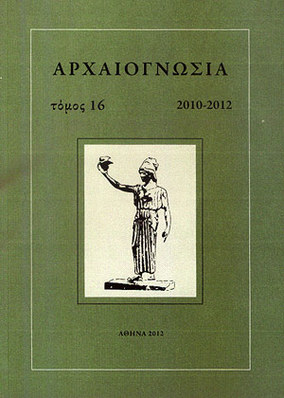Κλασικά επιτύμβια ανάγλυφα από τη Μακεδονία
Part of : Αρχαιογνωσία ; Vol.15, No.1-3, 2007, pages 253-316
Issue:
Pages:
253-316
Parallel Title:
Grave reliefs of the 5th and 4th century B.C. from Macedonia
Section Title:
Σύμμεικτα - Miscellanea
Author:
Abstract:
From the study of the macedonian grave reliefs of the fifth and fourth century B.C. it becomes obvious that the vast and diverse geographical area of the northern Aegean never constituted an homogenous cultural and artistic entity, like i.e neighbouring Thessaly. Local (marble carving) workshops operated independentlyfrom each other, having their particular characteristics and being influenced in various degrees and ways by the contemporary art produced in the major cultural centers of southern Greece. The colonisation of the Chalkidiki peninsula and the macedonian coast by southern greek states from the 7th century B.C. onward, combined with the emigration, on various occasions, of artists from other areas of the greek world, mainly Attica and the Ionian world, contributed to the opening of the area to major artistic influence from the big artistic centers of the South. That is the main reason for the higher quality and refinement commonly attested in macedonian works of art, especially funerary stelai, in comparison to other equally remoted areas, like Thessaly. Grave reliefs made their appearance in Macedonia, rather late, in the middle of the 5th century B.C. The small number of 5th century grave reliefs from the area attests that the custom o f the marking of the grave with a relief stele was quite new in the area, probably imported. Probably, the main reason for the rarity of this kind of monuments in Macedonia is the lack of high quality marble in the area. The almost simultaneous appearance of grave reliefs in thessalian and macedonian cemeteries is due to the emigration o f Ionian artists, from parts of southern Greece, coastal Asia Minor and the islands, to these two areas, as eloquently revealed by the artifacts themselves. Soon new workshops were established and operated in the area consisting of both Ionian immigrants and local artists, establishing a new artistic tradition in Macedonia, with, as is commonly perceived, strong ionic roots. During the 4th century B.C, ionic influence on macedonian funerary reliefs remains strong, especially during the first quarter of the century. In the course of time iconographical influence from attic grave stelai became stronger and more obvious. New immigrants from Athens, during the last decades of the Peloponnesian war, are drawn to the area due to the rising wealth and power of the macedonian stale under Archelaos, patron of arts and admirer of athenian culture. Influence of athenian art in the region is solidified when in the end of the 4th century, once more, immigrants from Athens arrive in rich and powerful, due to the persian conquest, Macedonia, in their quest for work opportunities. A group of monumental grave monuments at Vergina (ancient Aigai) and Pella, which resemble a lot to their athenian counterparts of the last decade of the fourth century, attest the presence o f athenian artists in the area. Artists from neighbouring Thessaly also immigrated to Macedonia as attested by the work of a provincial 'macedonian - thessalian” workshop at Aiani and the capital city, Pella. Five grave reliefs from these two areas have been attributed to the workshop, all dated in the third quarter of the 4th century. At the same time, local workshops continued to operate in various regions of Macedonia (Pella, Pieria, etc), faithful to their ionic artistic tradition. Classical grave reliefs from Macedonia, and macedonian art in general, eloquently reveal the many aspects of macedonian society of the 5th and 4th centuries B.C. and the complex cultural interactions that occurred in that remote region of the Greek world ; interactions which are as interesting and exciting as their study.
Subject:
Subject (LC):
Keywords:
Ανάγλυφα επιτύμβια μνημεία
Notes:
Το άρθρο περιέχει ευχαριστίες προς την καθηγήτρια κα Ο. Παλαγγιά για τις πολύτιμες συμβουλές και παρατηρήσεις της στο αρχικό κείμενο.




